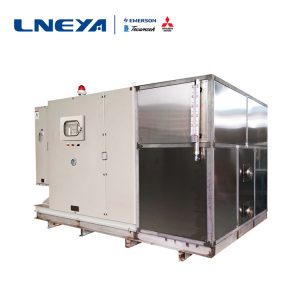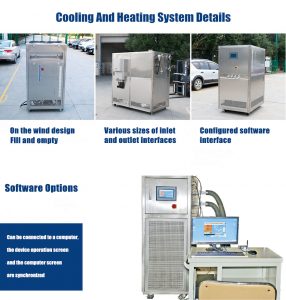Points for attention in the selection of industrial heating and cooling machines
In food factories, pharmaceutical factories, biology, new material processing, and chemical plants, the raw materials in the reactor need to be cooled rapidly during the industrial production process involved in the reactor. In order to achieve the purpose of rapid cooling, it is necessary to directly cool down the reactor, so as to achieve the purpose of indirectly reducing the temperature of the material in the reactor.
At present, there are about three temperature control schemes for temperature ranges:
1. The room temperature type (5°C~35°C) is suitable for rapid cooling of general temperature. Davos recommends air-cooled chillers or water-cooled chillers according to the model;
2. The low-temperature type (-5°C~-40°C) is suitable for the process required for low-temperature reaction, and the general refrigerant is a mixed solution of ethylene glycol/sodium chloride and calcium chloride;
3. The ultra-low temperature type (-40°C~-115°C) is suitable for some special raw materials and processes to cool down. Purchase low-temperature cascade or two-stage refrigeration solutions.
Then our LNEYA has temperature control schemes for the 3 temperature sections, but the low-temperature chiller has a mixed liquid of ethylene glycol and water. The ultra-low temperature chiller adopts the exclusive technology single-machine self-cascading technology, secondary supercooling, and single fluid. In line with the commonly used cooling and heating equipment for reactors, there are different types of equipment for different working conditions. Commonly used models include SUNDISRHR, etc., with different powers, different temperature ranges, and different models.
Points to note about the selection of heating coolers: Pay attention to whether the site conditions of the project are air-cooled or water-cooled. If it is water-cooled, there must be a water source that meets the conditions on site. The temperature range is relatively wide, and the wider the temperature control condition, the more expensive the price is, but sometimes you can’t use such a wide temperature range, you can choose according to your actual temperature range, cooling or heating, or cooling and heating at the same time, so that Choose according to your exact working conditions. Attention should be paid to the flow rate of the inlet and outlet of the matching reactor, do not choose large or small.

Recommandations connexes
-
Comment traiter les fuites de réfrigérant lors du traitement des déchets organiques ?
1184Au cours du processus de traitement des gaz résiduaires organiques, s'il est constaté que le réfrigérant fuit, il est recommandé de le traiter à temps. Le fabricant professionnel de traitement des gaz résiduaires organiques LNEYA analyse ensuite les connaissances en matière de traitement des gaz résiduaires organiques...
Voir les détails -
Application and function of explosion-proof constant temperature circulation system
989Temperature control in drug research and development and chemical experiments, as well as temperature control in small-scale experimental production and industrial production, all require highly dynamic constant temperature controllers. The chemic...
Voir les détails -
Réfrigérateur antidéflagrant - Convient aux usines de production mécanique
1482Le réfrigérateur antidéflagrant LNEYA est un type de réfrigérateur spécial principalement utilisé dans un environnement industriel particulier pour conserver des marchandises dangereuses difficiles à conserver, volatiles, inflammables et explosives. Avec le développement de l'essence...
Voir les détails -
Analyse des causes du bruit généré par le fonctionnement des refroidisseurs à basse température
1037Le bruit est courant dans le fonctionnement des équipements industriels. Il y a de nombreuses raisons au bruit, qui peut être causé par certains problèmes environnementaux dans l'installation. Lorsqu'un bruit est généré, nous devons d'abord en confirmer la cause et déterminer s'il s'agit d'un problème inter...
Voir les détails
 LNEYA Industrial Chillers Fabricant Fournisseur
LNEYA Industrial Chillers Fabricant Fournisseur














